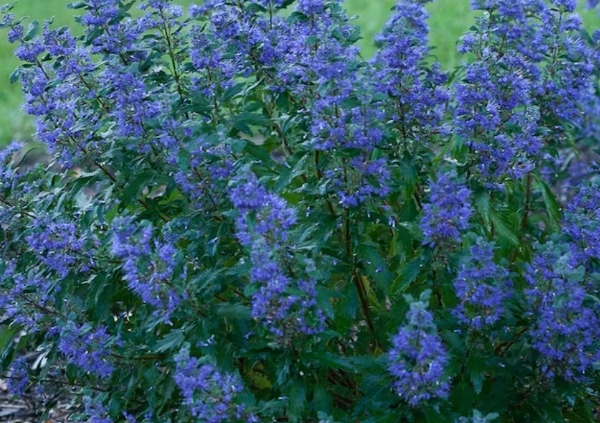
Caryopteris
Botanical Name
:
Caryopteris spp.
Plant Type
:
Deciduous shrub
Seasons
:
Plant in spring or fall; Blooms in late summer and early fall
Sun Level
:
Full sun; 6 or more hours of direct sunlight a day
Ideal Soil Temperature for Planting
:
Moderate temperatures are best (65 to 85°F); avoid planting when the ground is frozen
Soil Type
:
Well-drained, loamy or sandy soil; intolerant of wet, clay soils
Hardiness Zones
:
5–9 (USDA)
Germination
:
Can be propagated by seed, but cuttings are preferred for most species
P.H. Level
:
Neutral to slightly alkaline (6.0–8.0)
Water/Irrigation
:
Water regularly after planting to establish. Once established, it is drought-tolerant. Avoid overwatering
Fertilization
:
Light mulching and organic matter during planting is good. Established plants often need little to no fertilizer.
Habit
:
Mounding, bushy form with a slightly spreading habit, creating a compact and full appearance
Propagation
:
Softwood cuttings in spring or semi-hardwood cuttings in summer
Final Plant Height
:
2–4 ft (can vary slightly depending on cultivar)
Spread
:
2–4 ft
Flowers
:
Small, fragrant, blue (various shades), or occasionally pink or white flowers borne in clusters along the stems
Attracts
:
Bees, butterflies, and hummingbirds
Uses
:
Border plant, specimen plant, container gardening, butterfly gardens
Companions
:
Coneflowers (Echinacea), Russian sage (Perovskia), and ornamental grasses
Pruning
:
Prune in late winter or early spring before new growth begins. Cut back to about half its height to encourage bushier growth and more flowers
Toxicity
:
Typically non-toxic to humans and pets, but it’s always best to avoid ingestion of any ornamental plant
Pests
:
Generally pest-resistant, but watch for spider mites and aphids
Diseases
:
Generally disease-resistant but root rot can occur in poorly drained soil
Fun Fact
:
The name Caryopteris comes from the Greek words “karyon” (nut) and “pteron” (wing), referring to the winged seeds
Additional Info
:
Sometimes confused with Buddleja (butterfly bush) due to similar flower colors and attraction to butterflies, but Caryopteris blooms later in the season
Botanical Name
:
Caryopteris spp.
Plant Type
:
Deciduous shrub
Seasons
:
Plant in spring or fall; Blooms in late summer and early fall
Sun Level
:
Full sun; 6 or more hours of direct sunlight a day
Ideal Soil Temperature for Planting
:
Moderate temperatures are best (65 to 85°F); avoid planting when the ground is frozen
Soil Type
:
Well-drained, loamy or sandy soil; intolerant of wet, clay soils
Hardiness Zones
:
5–9 (USDA)
Germination
:
Can be propagated by seed, but cuttings are preferred for most species
P.H. Level
:
Neutral to slightly alkaline (6.0–8.0)
Water/Irrigation
:
Water regularly after planting to establish. Once established, it is drought-tolerant. Avoid overwatering
Fertilization
:
Light mulching and organic matter during planting is good. Established plants often need little to no fertilizer.
Habit
:
Mounding, bushy form with a slightly spreading habit, creating a compact and full appearance
Propagation
:
Softwood cuttings in spring or semi-hardwood cuttings in summer
Final Plant Height
:
2–4 ft (can vary slightly depending on cultivar)
Spread
:
2–4 ft
Flowers
:
Small, fragrant, blue (various shades), or occasionally pink or white flowers borne in clusters along the stems
Attracts
:
Bees, butterflies, and hummingbirds
Uses
:
Border plant, specimen plant, container gardening, butterfly gardens
Companions
:
Coneflowers (Echinacea), Russian sage (Perovskia), and ornamental grasses
Pruning
:
Prune in late winter or early spring before new growth begins. Cut back to about half its height to encourage bushier growth and more flowers
Toxicity
:
Typically non-toxic to humans and pets, but it’s always best to avoid ingestion of any ornamental plant
Pests
:
Generally pest-resistant, but watch for spider mites and aphids
Diseases
:
Generally disease-resistant but root rot can occur in poorly drained soil
Fun Fact
:
The name Caryopteris comes from the Greek words “karyon” (nut) and “pteron” (wing), referring to the winged seeds
Additional Info
:
Sometimes confused with Buddleja (butterfly bush) due to similar flower colors and attraction to butterflies, but Caryopteris blooms later in the season
Written by Nondiah Khalayi – https://www.linkedin.com/in/nondiah-khalayi/

